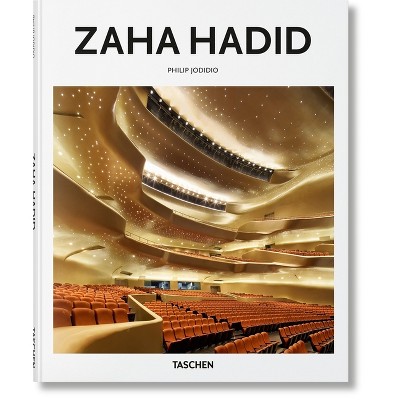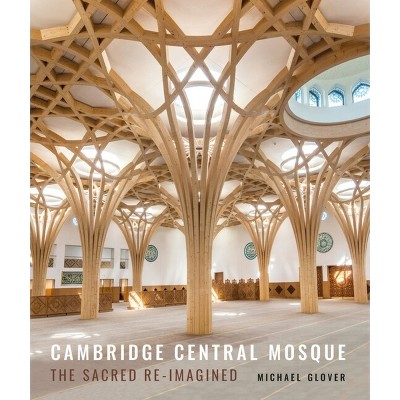Sponsored

Zaha Hadid's Paintings - by Desley Luscombe (Hardcover)
In Stock
Sponsored
About this item
Highlights
- Zaha Hadid is widely regarded as a visionary and influential architect, who became globally acclaimed by the time of her untimely death in 2016.
- About the Author: Desley Luscombe is Emeritus Professor of Architecture at University of Technology Sydney, Australia.
- 176 Pages
- Architecture, Design, Drafting, Drawing & Presentation
Description
Book Synopsis
Zaha Hadid is widely regarded as a visionary and influential architect, who became globally acclaimed by the time of her untimely death in 2016. This book is the first to focus on how painting was fundamental to her practice. During the first 20 years of her career, she earned her reputation through 'paper architecture' projects which were widely published in architecture journals and exhibited, but which remained largely unbuilt. Influenced by the Suprematists, she used her paintings as design tools and abstraction as an investigative structure for imagining architecture.
Drawing extensively on interviews with Hadid's contemporaries and her team of assistants and her past presentations and in-depth interviews, this book is the first to focus on the important aspect of Hadid's work. It examines selected paintings in detail, both critically assessing them in the wider context of 20th-century fine art - in relation to the Suprematists, de Stijl, Cubism and Futurism - and offering insights into how Hadid used the paintings to develop architectural and spatial ideas, which she would later realise in her buildings. The paintings were created at a pivotal time in architecture, just before the move away from hand drawing to computers and many of Hadid's paintings pre-empt the potential of digital and virtual reality.
Review Quotes
'Around ten years since the death of Zaha Hadid, I am deeply touched to hold Desley Luscombe's publication on Zaha's drawings in my hands. These marvellous drawings, which once caused a sensation at the beginning of her career, were initially recognized by the architectural world as the work of a great artist, but definitely not that of an architect. But Zaha convinced everyone of the opposite.
'She was one of the few female architects of her time and played a key role in shaping the image of women in architecture. What is particularly impressive is how she asserted herself in London's male-dominated architecture scene and ultimately established a place for herself. Her path was by no means easy, and she had to fight hard to realize her visions and to be accepted. At her very first exhibitionThe Peak Competition Exhibition, Hong Kong, 1983, which we showed at Aedes, the visitors' reactions were characteristic: 'Oh, she can build too.' From artistic drawings to realized architecture, Zaha showed that she was not only capable of creating beautiful images, but that these could also serve as the basis for innovative and groundbreaking buildings. Whether working in two or three dimensions, she showed that her art and her architecture were intrinsically linked.
'In Zaha Hadid, the world lost an outstanding personality, a genius and an inspirational mind who constantly pushed the boundaries of architecture. Her spectacular drawings and pioneering architecture are an impressive testimony to her uniqueness and visionary spirit. She left behind a legacy that continues to inspire architects and artists around the world and has permanently changed the way we perceive space and structure. This publication is not only a tribute to Zaha Hadid's extraordinary career, but also an invitation to revisit her work and appreciate its importance to contemporary architecture drawings. These are more than just working sketches; they are an expression of her deep, theoretical reflections and her tireless search for new forms and spaces. Zaha Hadid's work remains a shining example of the transformative power of art and architecture.' - Dr.h.c. Kristin Feireiss, Director of Aedes Architecture Forum, Berlin
'Desley Luscombe's book is extremely well informed and is based on multiple interviews with Hadid's colleagues who were instrumental in producing the paintings. Her perceptive and insightful readings of individual paintings trace how painting evolved as one of Hadid's critical design tools, a tool that Luscombe argues was both reflective and projective. The book brilliantly captures and evokes the intellectual, cultural and creative milieu of London and the AA in the 1970s and 80s. Drawing on the debates and dramas of the times and documenting the intense speculation and hard work by Zaha and her teams of collaborators, this is a compelling and authentic narrative of the formative years of one of our greatest architects.' - Nicholas Boyarsky, Professor of Architecture, RMIT University and Director, Boyarsky Murphy Architects
'Desley Luscombe's important book, structured through a sequence of case studies, explores the paintings of Zaha Hadid and the contexts within which they were produced and circulated. We learn about how they were made and their complex relationship with the projects, of which they are instantiations rather than depictions. Through its detailed discussion and extensive visual documentation, this excellent study expands, renews and refines our understanding of Hadid's remarkable body of work.' - Mark Dorrian, Forbes Chair in Architecture, University of Edinburgh and Editor-in-Chief, Drawing Matter Journal
'With Luscombe's book Hadid's paintings finally receive a scientific analysis that convincingly explains their meaning and function within her complex oeuvre. An eye-opening read!' - Phillip Ost
'Zaha Hadid endures as one of the great architects of the postwar period. Her work while positioned within the digital turn that occurred in the 1990s retains a singularity that continues to define it beyond the now perceived restrictions of that turn. Part of the singularity can be found in the array of prompts engendering it. Equally, it can be located in the modes of experimentation that occasioned it. Fundamental to the latter was painting. Hadid's own paintings functioned as loci of experimentation. It was in the paintings that spatial relations, colour and the possible overcoming of restrictive geometries were first worked out. The unique role of painting as experimentation in her work has not been analysed until now. Desley Luscombe's ground-breaking study of the role of painting in Hadid's practice gives rise to a radical reassessment of Hadid's work. Luscombe's book combines scrupulous analysis of the paintings, traces their history with meticulous detail and shows the differing way in which they figure within subsequent drawings and projects. This is a book of profound importance. It will alter the way drawing and painting are understood as part of architecture's experimental practice.' - Andrew Benjamin, Honorary Professorial Fellow, Faculty of Arts University of Melbourne
About the Author
Desley Luscombe is Emeritus Professor of Architecture at University of Technology Sydney, Australia. While at UTS she held the position of Dean of Faculty of Design Architecture and Building from 2004-2016. From 1977, she was founding partner of Campbell Luscombe Architects (Sydney). While achieving her PhD in Renaissance Studies, Luscombe's current research focuses on twentieth-century architectural drawings.
Shipping details
Return details
Trending Non-Fiction






Discover more options





